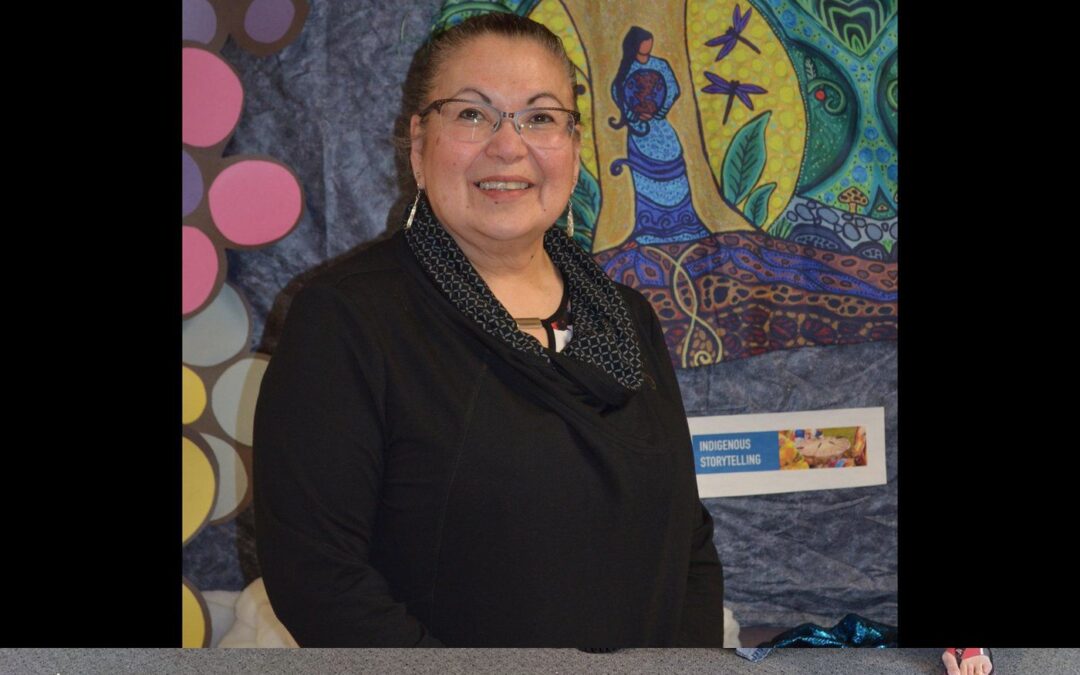Sharon Meyer, the First Nation and Métis consultant for the North East School Division, spoke about her experiences for International Women’s Day. Photo by Angelin Comfort
Sharon Meyer came from a generation of milestones.
“I came from the generation of the firsts – the first First Nation to become a doctor, dentist, female principal, and so on,” she said, speaking about her experience for International Women’s Day, held this year on March 8.
Meyer convocated with distinction from the ITEP (Indian Teacher Education Program) University of Saskatchewan in 1991, beginning a 32-year career in education. Now, she is the First Nation and Métis consultant for the North East School Division, helping incorporating Indigenous ways of learning into the classroom. She is retiring this school year.
“It is sad that in some areas of careers and employment we are still waiting for the first but it gives me hope to know how our young females are feeling empowerment and confidence to be leaders,” she said.
Her childhood was not an easy road. There was poverty, racism, lack of First Nation role models but she persevered and her love of learning and at most times school being a safe place paid off for her in the end.
“Entering university as a mature adult with two young daughters was a scary time of my life. But once I sat in my first class and found myself surrounded with my brown brothers and sisters – all sitting there with the same purpose to get an education degree – I thought I am going to do this!” she said.
She worked really hard and was rewarded by convocating with distinction and recipient of the Bates Award and Aurora Award for teaching excellence during her internship. Meyer was also awarded nine scholarships throughout her university career. In 2006 Meyer was rewarded with the University of Saskatchewan Alumni Excellence for the Aboriginal Initiatives Award.
Meyer began her career in 1991 in education and worked at several different schools as a teacher, vice-principal and principal. In the summer of 2011 she moved to the community of Carrot River, married and started with the NESD in 2012 as the First Nation and Métis Education consultant.
Meyer said that her late mother was her role model and a hard worker.
“She had a Grade 4 education but was trilingual (French, Cree and English).”
Meyer had two older sisters – survivors of residential schools.
“They persevered as parents and despite their trauma from residential school they valued the purpose of education and instilled that in the younger generation of our family. My Inuit professor during ITEP – she was my first Indigenous role model educator. I thought to myself if she can make it to this level of university then I can too! My first female principal in the third year of my teaching career. It was rare to have a female administrator back in the day – look how far society has come! She always encouraged me that I had the skills to be an administrator! Elder Maria Linklater instilled and rekindled a lot of cultural teachings through her stories.”
Meyer said her advice for young Indigenous women entering the workforce is to remember that they are role models for themselves and for those watching.
“We are still in a society mind set where we have to prove ourselves in a higher standard than the next employee. Don’t ever feel alone – there are so many role models ready to help you through the rough times.”
When asked what she wishes she knew earlier, she said, “I wish I knew about Intergenerational trauma. I would have understood my mother and siblings better.”
Meyer said among the keys to being successful is not believing the negative talk or put downs.
“I enjoy creating rewarding opportunities to share and create leadership in others. I do a lot of presentations, workshops, and conference sessions – if you’re ready to share in my experiences and stories – then I am ready to entertain, lead and teach you.”
Meyer admires the young First Nation ladies and teens rising up.
“They have had a stronger foundation than I had as a child and as a student. Their voice is stronger and they know who they are and where they come from. We have so many First Nation women chiefs in our Saskatchewan reserve communities when I was growing up there was only one First Nation women chief. We also have our first OTC (Office of the Treaty Commissioner) woman commissioner. I celebrate the young voices!” she said.
By: Nicole Goldsworthy, Local Journalism Initiative Reporter, Humboldt Journal
